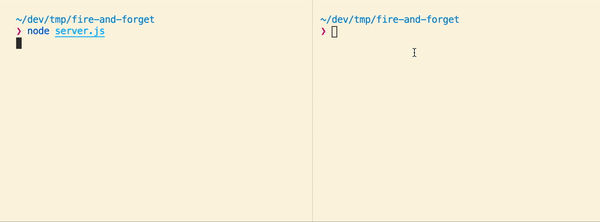In most cases, we care about the results of our HTTP Requests. But sometimes, it’s just about making the request, and not so much about the response. In these cases, it may be wise to save yourself some network bandwidth by ignoring the response entirely.
I’m building a task queueing solution for Next.js! Check out Quirrel, I think you’ll like it ☺️
How does this work?
HTTP Requests are based on TCP connections.
Running curl google.com will open up a TCP connection to google.com:80 and send roughly the following:
GET / HTTP/1.1
Host: google.com
User-Agent: curl/7.64.1
Accept: */*
| Line | Meaning |
|---|---|
| 1 | Request Line. Contains Method, Location and Protocol Version |
| 2 | The only required header: “Host” |
| 3, 4 | Some Headers |
| 5 | blank line to separate header and body |
Normally, you’ll then wait for the server to respond like so:
HTTP/1.1 200
Content-Type: text/html
<html><head> ...
But the response isn’t of interest to us. We’ll just send off our request, then terminate the TCP connection and carry on with more interesting stuff.
A rough test implementation
The first thing we need is a test server we can make our calls against:
const http = require("http");
http
.createServer((req, res) => {
req.on("end", () => {
setTimeout(
() => {
console.log("Done");
res.statusCode = 200;
res.end("Done");
},
1000
);
});
})
.listen(5000);
To simulate time-consuming work, this server delays responding by one second.
Now onto the interesting part: Making the manual HTTP request.
const net = require("net");
const client = new net.Socket();
client.connect(5000, "localhost", () => {
// request line
client.write("POST / HTTP/1.1\r\n");
// headers
client.write("Host: localhost:5000\r\n");
client.write(`Content-Length: 11\r\n`);
// blank line
client.write("\r\n");
// body
client.write("Hello World");
// end the connection prematurely
client.destroy();
});
client.on("close", () => {
console.log("Connection Closed");
});
It’s rather simple!
We open up the connection to localhost:5000 and dispatch the request.
The important line is the call to client.destroy(), which will end the socket immediately after the request has been transmitted.
Let’s see it in action:

Conclusion
Fire-and-forget HTTP calls aren’t that hard to make. They can be of use in bandwith-constrained environments - I will probably make use of them for Quirrel.
If this post was useful or interesting to you, make sure leave a comment or write me a message on Twitter! I always love to hear about my content helping others.
